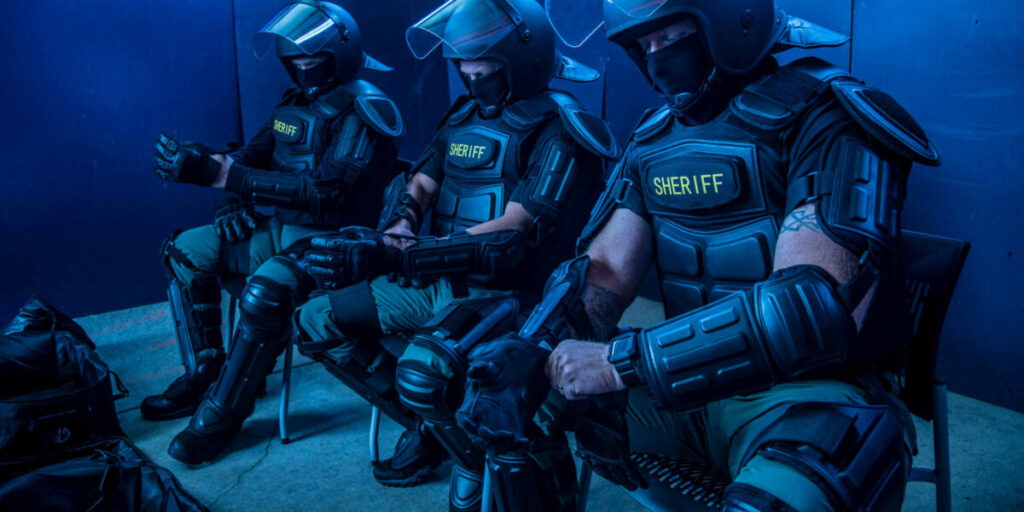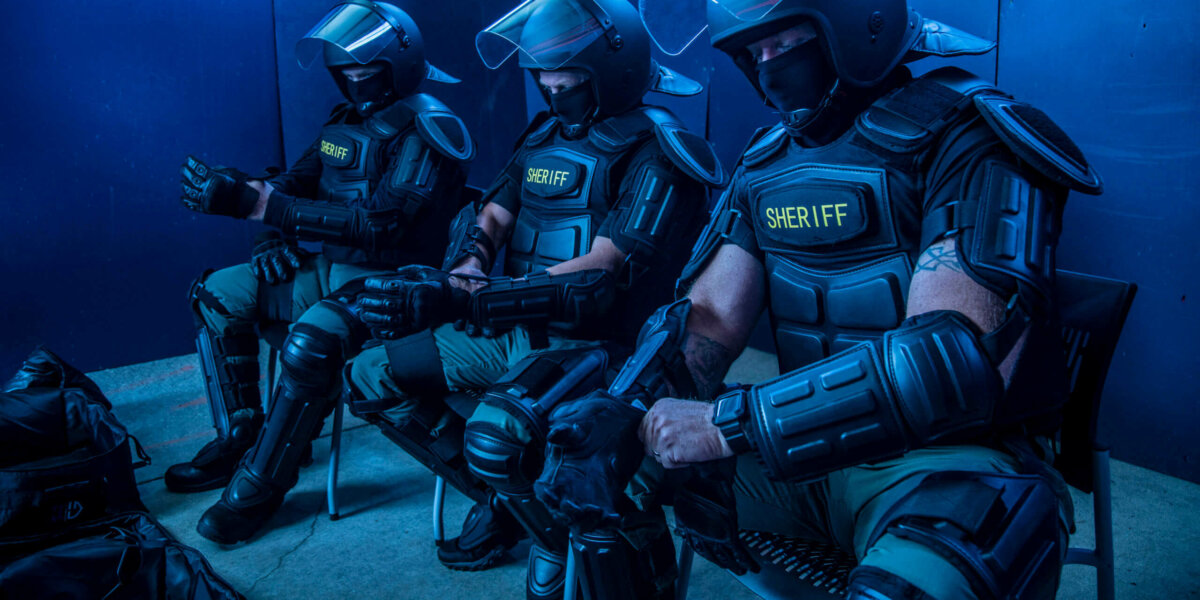
Heavy Riot Gear: Understanding Protection, Legality, and Ethical Use
In an increasingly complex world, the need for effective and responsible law enforcement is paramount. One of the most critical tools available to police forces and security personnel during civil unrest is heavy riot gear. This equipment is designed to provide maximum protection against a variety of threats, from thrown objects to more dangerous projectiles. Understanding the purpose, legality, and ethical considerations surrounding heavy riot gear is crucial for both law enforcement professionals and the public.
What is Heavy Riot Gear?
Heavy riot gear typically encompasses a comprehensive suite of protective equipment designed to safeguard officers during riots and other forms of civil disorder. This gear often includes:
- Helmets: Made from high-impact resistant materials, helmets protect the head from blunt force trauma and projectiles. They often include face shields for additional protection.
- Body Armor: Consisting of hard plates and padding, body armor protects the torso from impacts, stabbings, and projectiles.
- Leg and Arm Protectors: These protect the limbs from blows, cuts, and burns.
- Shields: Large, transparent shields provide a mobile barrier against thrown objects and close-quarters attacks.
- Gloves: Providing hand protection while maintaining dexterity.
The primary purpose of heavy riot gear is to minimize injuries to law enforcement personnel, allowing them to maintain order and protect the public. This equipment is not intended for offensive purposes but rather for defensive protection in volatile situations.
The Importance of Riot Gear
The use of heavy riot gear is essential for several reasons:
- Officer Safety: Protecting officers from injury is paramount. Injured officers cannot effectively maintain order or protect citizens.
- Maintaining Order: By providing a physical barrier and reducing the risk of injury, heavy riot gear allows officers to maintain control of a situation and prevent escalation.
- Deterrence: The visible presence of officers equipped with heavy riot gear can act as a deterrent to violence and property destruction.
- Public Safety: When law enforcement can effectively control a riot or civil disturbance, they can better protect the safety and property of the general public.
Legality and Regulations Surrounding Riot Gear
The legality of heavy riot gear varies depending on the jurisdiction. In many countries, law enforcement agencies are authorized to use this equipment under specific circumstances, typically involving a declared state of emergency or a significant threat to public order. However, there are often strict regulations governing its use, including:
- Authorization: Only authorized personnel are permitted to use heavy riot gear.
- Training: Officers must receive adequate training in the proper use of the equipment, including de-escalation techniques and the use of force continuum.
- Accountability: Agencies must have mechanisms in place to track the use of heavy riot gear and hold officers accountable for any misuse or abuse.
- Transparency: Policies regarding the use of heavy riot gear should be publicly accessible to ensure transparency and build public trust.
It’s crucial to note that the use of heavy riot gear must always be proportional to the threat and in accordance with the law. Excessive or unnecessary force can have serious legal and ethical consequences. [See also: Crowd Control Tactics and Legal Ramifications]
Ethical Considerations
Beyond the legal aspects, the use of heavy riot gear raises important ethical considerations. While the equipment is designed to protect officers, it can also be perceived as intimidating or aggressive, potentially escalating tensions in an already volatile situation. Some key ethical considerations include:
- De-escalation: Prioritizing de-escalation techniques whenever possible to avoid the need for heavy riot gear.
- Proportionality: Using only the necessary amount of force to achieve a legitimate law enforcement objective.
- Discrimination: Ensuring that the use of heavy riot gear is not applied in a discriminatory manner based on race, ethnicity, or other protected characteristics.
- Transparency: Being transparent about the reasons for using heavy riot gear and the policies governing its use.
- Accountability: Holding officers accountable for any misuse or abuse of the equipment.
Maintaining public trust is essential for effective law enforcement. When the use of heavy riot gear is perceived as excessive or unjustified, it can erode public confidence and lead to further unrest. [See also: Building Community Trust in Law Enforcement]
The Role of Technology in Riot Control
Technology plays an increasingly important role in riot control. In addition to heavy riot gear, law enforcement agencies are utilizing various technological tools to manage civil unrest. These tools include:
- Surveillance Technology: Drones, CCTV cameras, and body-worn cameras can provide real-time situational awareness and help identify individuals engaged in illegal activities.
- Communication Systems: Secure communication systems are essential for coordinating law enforcement efforts and disseminating information to the public.
- Less-Lethal Weapons: Technologies such as tear gas, pepper spray, and rubber bullets can be used to disperse crowds and subdue individuals without causing serious injury.
- Data Analytics: Data analytics can be used to identify potential hotspots for unrest and predict the likelihood of violence.
However, the use of technology in riot control also raises privacy concerns. It’s important to strike a balance between the need for effective law enforcement and the protection of individual rights. [See also: The Ethics of Surveillance Technology in Law Enforcement]
Training and Best Practices
Proper training is essential for the safe and effective use of heavy riot gear. Law enforcement agencies should provide comprehensive training to all officers who are authorized to use this equipment. Training should include:
- Equipment Familiarization: Officers must be thoroughly familiar with the proper use and maintenance of all components of heavy riot gear.
- De-escalation Techniques: Officers should be trained in de-escalation techniques to avoid the need for force whenever possible.
- Use of Force Continuum: Officers should be trained in the use of force continuum, which outlines the appropriate level of force to use in different situations.
- Crowd Control Tactics: Officers should be trained in effective crowd control tactics, including formations, communication, and the use of less-lethal weapons.
- First Aid: Officers should be trained in basic first aid to provide assistance to injured individuals.
In addition to training, law enforcement agencies should also adopt best practices for the use of heavy riot gear. These best practices should include:
- Clear Policies: Agencies should have clear policies governing the use of heavy riot gear.
- Supervision: The use of heavy riot gear should be closely supervised by experienced officers.
- Documentation: All uses of heavy riot gear should be thoroughly documented.
- Review: Agencies should regularly review their policies and practices regarding the use of heavy riot gear to ensure that they are effective and ethical.
The Future of Riot Control
As societies continue to evolve, the challenges of maintaining order and protecting public safety will likely become more complex. The future of riot control will likely involve a combination of advanced technology, improved training, and a greater emphasis on de-escalation and community engagement. While heavy riot gear will likely remain an important tool for law enforcement, it’s crucial to ensure that its use is always guided by ethical principles and a commitment to protecting the rights and safety of all citizens.
Conclusion
Heavy riot gear is a critical tool for law enforcement agencies responsible for maintaining order during civil unrest. It provides essential protection for officers, allowing them to effectively manage volatile situations and protect the public. However, the use of heavy riot gear must be carefully regulated and guided by ethical considerations. Proper training, clear policies, and a commitment to transparency and accountability are essential to ensure that this equipment is used responsibly and effectively. As technology continues to evolve, the future of riot control will likely involve a combination of advanced tools, improved training, and a greater emphasis on de-escalation and community engagement. Ultimately, the goal is to maintain order and protect public safety while upholding the rights and freedoms of all citizens. The responsible and ethical deployment of heavy riot gear is a vital component of achieving this goal.

